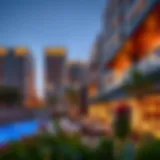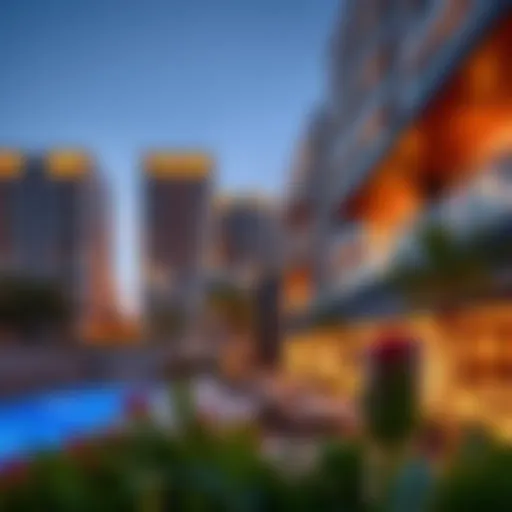Exploring شارع السيف التراثي: Dubai's Cultural and Economic Soul


Intro
شارع السيف التراثي is not just a picturesque street in Dubai; it serves as a bridge between the past and the modern urban landscape. As you stroll along this vibrant thoroughfare, it becomes clear that it encapsulates the spirit of the city’s rich cultural heritage. The street is a tapestry of architectural brilliance, a hub of economic activity, and a living museum showcasing Dubai's evolution over time.
Visitors and locals alike are drawn to its unique blend of tradition and contemporary elements, further elevating its importance in Dubai’s urban framework. In this exploration, we will delve into the historical significance of this street, review its architectural treasures, examine its economic contributions, and illustrate its pivotal role in the ever-changing narrative of the city.
By shedding light on the evolution of شارع السيف التراثي, we aim to provide property investors, agents, and analysts with valuable insights into the area's potential as an investment opportunity. Understanding the culture and economic landscape of this heritage-rich street is crucial for anyone looking to make informed decisions in Dubai's dynamic real estate market.
Historical Significance of شارع السيف التراثي
Understanding the historical significance of شارع السيف التراثي is not just about gazing at its traditional architecture or marveling at the bustling markets; it goes much deeper. This street is a vibrant artery that pulses with the lifeblood of Dubai’s rich heritage and culture. By examining the elements that make شارع السيف التراثي unique, we can appreciate why it stands as more than a mere thoroughfare—it's a vital link to the past, present, and future of the emirate.
Origins and Early Development
The roots of شارع السيف التراثي date back to a time when Dubai was a humble fishing village. Established by the creek, it served as a center for trade and commerce. The early development of this area was influenced heavily by its geographical position, allowing for easy access to trading routes. Families made their livings by fishing and pearl diving, and as a result, the community began to flourish.
Initially, the architecture reflected the simple, practical needs of the inhabitants—houses built of coral stone and palm fronds, closely knitted together. As traders arrived, the street evolved from a local gathering spot into a marketplace that attracted visitors from far and wide. Its original charm is still palpable, with many elements preserved, offering a glimpse into what life was like in the early days of Dubai.
In short, شارع السيف التراثي is a living history book, showcasing how Dubai transformed from a modest locale into a thriving economic hub.
Cultural Influences Over Time
Over the decades, شارع السيف التراثي has absorbed various cultural influences as a result of its position as a trading post. Visitors from different backgrounds—Bahrainis, Iranians, and even Europeans—have all left their mark on the cultural landscape. As the city expanded, so did the diversity of its inhabitants, each contributing to the rich mosaic that defines modern Dubai.
For instance, the architectural styles saw convergence, blending traditional Emirati elements with influence from various cultures. The streets became a collision point for different languages, foods, and traditions, enriching the local culture. This ongoing exchange of ideas and customs is what keeps the spirit of شارع السيف التراثي alive, creating a space where unity in diversity is celebrated.
"The key to understanding a culture lies not in its monuments, but in its spaces where memories are made."
Historical Landmarks and Monuments
The historical landscape along شارع السيف التراثي is littered with landmarks that tell stories of the past. One such notable site is the Al Fahidi Fort, which dates back to 1787—an excellent example of the fortification architecture of the period. Museums housed within these structures offer insights into Dubai’s evolution over the years.
Additionally, the street features beautifully maintained wind towers indicative of traditional Emirati design, helping to keep homes cool long before air conditioning was a notion. Markets are another key feature where locals trade everything from spices to handicrafts, showcasing the craftsmanship linked to the region’s rich legacy.
This vibrant blend of historical landmarks makes شارع السيف التراثي not only a vital part of Dubai but also a celebrated heritage destination—attracting both tourists and the curious local population.
In summary, the historical significance of شارع السيف التراثي lies in its roots, cultural absorption, and the landmarks that stand guard over its storied past, showcasing a path to the future for the next generation.
Architectural Features of شارع السيف التراثي
The architectural essence of شارع السيف التراثي stands not just as a visual spectacle but as an embodiment of Dubai's cultural narrative. This section sheds light on the distinctive architectural features that characterize the street, detailing both the blend of traditional and contemporary aesthetics and their implications for investors and urban developers alike.
Traditional vs. Modern Design Elements
When one walks along شارع السيف التراثي, the interplay between traditional Arabic architecture and modern design becomes apparent. The traditional elements often feature intricate calligraphy and geometric patterns, showcasing the rich heritage of the region. These details are seen on facades of buildings which reflect Islamic artistry through mashrabiya—wooden latticework that provides shade and privacy while exhibiting exquisite craftsmanship.
Conversely, modern design elements introduce a sleekness and functionality that appeals to today’s urban lifestyle. Glass structures and open spaces offer a stark contrast to the old-world charm, allowing natural light to spill into common areas. This combination paints a picture of a street that honors its history while embracing the future.
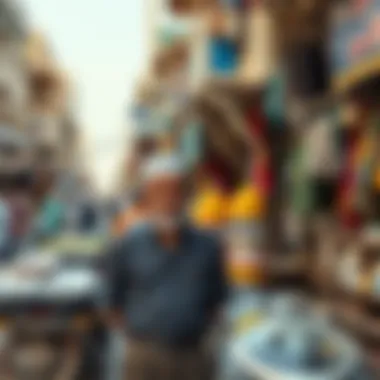

"The success of شارع السيف التراثي relies on marrying the old with the new, creating an atmosphere that's inviting and culturally rich."
Significance of Local Materials
Local materials play a vital role in crafting the identity of شارع السيف التراثي. Using materials like coral stone, mud, and fired clay not only helps maintain aesthetic harmony with traditional designs but also highlights a commitment to sustainability. The benefits of these materials extend beyond aesthetics. They regulate temperature naturally, making interiors more comfortable amid Dubai's scorching climate. Additionally, sourcing materials locally supports regional artisans and contributes to the local economy. This involves investors looking at sustainable development as a fundamental aspect of their projects.
Public Spaces and Their Design
Public spaces within شارع السيف التراثي serve as the backbone of community interaction. Thoughtfully designed plazas and gathering areas promote a sense of unity among visitors and locals. These spaces are often adorned with fountains and greenery, enhancing both the visual appeal and comfort of the environment.
The design considerations involved aim to create accessibility for everyone. Wide walkways, shaded areas, and seating arrangements are thoughtfully arranged to encourage social interactions. Moreover, such features cater to both tourists and residents, creating a vibrant atmosphere full of activity.
In summary, understanding the architectural features of شارع السيف التراثي is crucial for stakeholders aiming to leverage the potential of this cultural hub while respecting its heritage. The clash of traditional and modern elements, combined with smart design using local materials, guarantees that the street remains not only an economic powerhouse but also a cherished part of Dubai's identity.
For more information on traditional architecture in Dubai, you can explore resources such as: Britannica or Wikipedia.
Economic Impact of شارع السيف التراثي
The economic impact of شارع السيف التراثي is significant, functioning not just as a street but as a catalyst for growth within the region. The continuous development of this area provides a unique case study about urban economic dynamics. Investors and business owners find it essential to grasp the crucial elements that contribute to commercial vitality and potential growth in this vibrant hub. By examining the commercial activities, the influx of tourists and investors, and the real estate opportunities that arise, one can appreciate the multifaceted economic landscape of شارع السيف التراثي.
Commercial Activities and Business Growth
شارع السيف التراثي actively pulses with commercial activities that contribute to Dubai’s robust economy. It’s a melting pot of local shops, cafes, and cultural venues that not only enrich the community but also attract business. Small businesses and startups find a nurturing ground here due to high foot traffic and a culturally inclined customer base.
- Diverse Offerings: Retailers cater to a variety of tastes, from traditional crafts to modern art. This diversity helps in drawing a wide-ranging clientele, thus boosting sales.
- Synergy: The collaboration between businesses often leads to innovative partnerships. For instance, a local café might host art displays or music events, connecting different sectors and enhancing customer experience.
Local entrepreneurs are seizing opportunities in this evolving market. As traditional businesses thrive in this culturally rich environment, larger companies are noticing the potential for expansion. Hence, we see franchise and brand development taking root over time, which in turn fuels job creation and economic stability.
Attracting Tourists and Investors
With the rise of global tourism, شارع السيف التراثي has positioned itself as a must-visit destination, drawing in locals and foreigners alike. The fusion of culture, history, and modern amenities appeals to a wide audience, enhancing its profile as a key player in Dubai’s tourism sector.
- Cultural Attractions: Events like festivals and markets attract tourists who want an authentic taste of Dubai’s heritage. This draws in foot traffic that directly benefits local businesses.
- Investment Opportunities: The growing tourist numbers underscore the street’s potential for investment. Investors are keen on real estate developments due to the street’s dual appeal as a leisure destination and a commercial corridor.
The surge in tourist interest also amplifies the need for enhanced facilities, which encourages further investment in infrastructure, increasing the street’s revenue streams.
Real Estate Opportunities Along the Street
Investments in real estate along شارع السيف التراثي have seen significant momentum. Given its strategic location and growing popularity, real estate offers enticing opportunities for both developers and investors.
- Development Projects: New commercial and residential properties are emerging, contributing to a varied real estate portfolio. Properties designed to blend with the cultural aesthetic attract buyers looking for unique investments.
- Rising Property Values: As demand for properties increases, so do property values. Investors eye this upward trend as a convincing case for long-term investment.
The dynamic nature of the neighborhood makes it a favorable spot for those looking to invest in Dubai’s flourishing landscape.
Cultural Events and Activities
Exploring the vibrancy of شارع السيف التراثي wouldn’t be complete without understanding the myriad cultural events and activities that take place within this iconic locale. These events play a crucial role in keeping the heritage alive while fostering a sense of community among residents and visitors alike. They serve as a celebration of identity, bridging the past with the present, and significantly enhancing the street's cultural landscape.
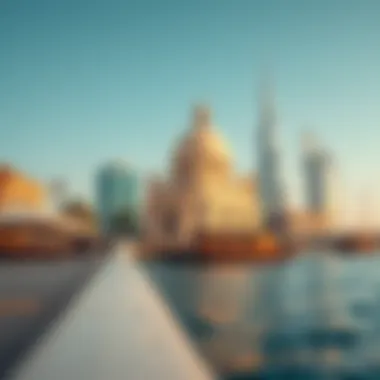

Festivals Celebrating Local Heritage
Festivals on شارع السيف التراثي are not just annual occurrences; they are deeply rooted traditions that resonate with the heart of Dubai’s cultural identity. Each festival presents an opportunity to engage with the customs and practices that have shaped the local community for generations. Events like the Dubai Heritage Festival and the Ramadan Nights festival spotlight local artisans, musicians, and chefs. These gatherings encourage visitors to immerse themselves in the local way of life.
- Cultural Exchange: Festivals promote cultural exchange by showcasing performances that illustrate Dubai's diverse cultures. Traditional dances like the Al Ayala, and live music create an exhilarating atmosphere.
- For Families: Many of these events cater specifically to families, offering workshops for children, storytelling sessions, or craft fairs where people can create their own souvenirs.
- Local Economy Boost: These festivals significantly contribute to the local economy by attracting tourists and increasing foot traffic in shops and restaurants along the street.
Art Exhibitions and Performances
Art showcases along شارع السيف التراثي redefine the connection between artists and the public. Art exhibitions display the works of both established and budding artists, often revolving around themes that celebrate authenticity. Many of these exhibits are hosted in open-air galleries or local community centers, making art accessible to everyone.
- Diverse Media: From paintings to digital art, the exhibitions reveal a multitude of perspectives that reflect the culture and innovations of Dubai.
- Live Performances: Performances like poetry readings, theater plays, and concerts enrich the cultural offerings. They attract local talents and renowned artists alike, presenting an engaging way for audiences to experience narratives that are both relatable and impactful.
- Community Involvement: Local residents are often invited to participate in these art events, fostering a collaborative spirit that strengthens community ties.
Community Engagement Initiatives
The essence of شارع السيف التراثي extends beyond exhibitions and festivals; it thrives on community engagement initiatives designed to empower locals. These programs aim to involve residents in various aspects of cultural preservation and creative expression.
- Workshops and Training: Various workshops focusing on traditional crafts, such as weaving or pottery, allow participants to learn from skilled artisans, ensuring that these age-old techniques continue to be practiced.
- Volunteer Programs: Community members are encouraged to volunteer in organizing events, allowing them to take ownership and pride in their cultural heritage.
- Sustainability Practices: Initiatives promoting sustainable practices, such as clean-up drives during festivals, teach the importance of preserving the street's beauty for future generations.
"Cultural events on شارع السيف التراثي remain a living archive, breathing life into traditions and fostering connections within the community."
These cultural events and activities not only invigorate the local economy but also enrich the social fabric of the area. For investors, understanding these dynamics offers significant insights. The greater community involvement and the consistent influx of visitors foster a strong market potential for businesses looking to capitalize on this rich cultural tapestry.
Visitor Experience on شارع السيف التراثي
The visitor experience on شارع السيف التراثي is an intricate tapestry woven from history, culture, and modern amenities. This area draws in a wide array of individuals—from curious tourists seeking a slice of local life to seasoned investors interested in its economic potential. It serves not just as a pathway, but as a meeting ground where history meets the hustle and bustle of contemporary Dubai.
When one strolls down شارع السيف التراثي, every step is rich with sensory experiences, making it essential for visitors to engage with this vibrant locale's offerings.
Navigating the Street
Navigating شارع السيف التراثي can be both straightforward and enriching. The area is designed with pedestrian-friendly walkways adorned with traditional decorative elements, allowing visitors to traverse seamlessly from one attraction to another. Signage, while in Arabic and English, makes it easier for international visitors to find their way.
However, the best route doesn’t always follow the signs. Often, the most delightful experiences come from veering off the beaten path. For instance, exploring side alleys might reveal cozy cafes or artisans crafting wares using inherited techniques.
It's also worth noting public transport options like Dubai's tram system or nearby metro stations that ease accessibility. Some visitors may prefer to rent bikes for a leisurely spin. This can be an excellent way to soak up the surroundings, especially during cooler evenings when the street comes alive with music and street performances.
Local Cuisine and Dining Options
Local cuisine along شارع السيف التراثي is another highlight that shouldn't be missed. The street is peppered with food stalls and restaurants, each offering a unique taste of Emirati dishes. Local favorites such as shawarma, mandi, and sweet treats like kunafa and baklava are definitely worth trying.
- Emirati Cuisine: For an authentic taste, you might want to hit Al Fanar Restaurant & Cafe, renowned for its traditional setup and flavors.
- International Fare: If you're in the mood for variety, check out Jumeirah Beach Hotel’s options, which serve a blend of Middle Eastern and Asian flavors.
- Cafes: Enjoy traditional Arabic coffee at Cafe Arabia, which captures the essence of the cultural experience.
Dining isn’t only about eating; it’s about relationships. Families and friends often gather here to bond over meals, showcasing the integral role of food in local culture. Therefore, taking the time to savor a meal will indeed enhance your overall experience.
Shopping and Souvenir Options
Shopping along شارع السيف التراثي provides a delightful mix of traditional and contemporary goods. The local markets, often referred to as souks, brim with textiles, spices, and handcrafted souvenirs that reflect the cultural heritage of the region.
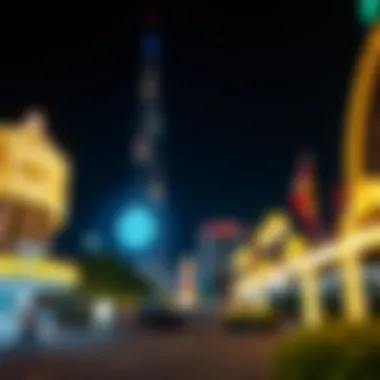

- Souvenirs to Consider:
- Handmade Jewelry: Locally sourced items often showcase traditional Emirati craftsmanship.
- Spices: The aromatic spices sold here can make for a great gift or personal treat.
- Textiles: Fabrics and garments can serve as beautiful reminders of your visit.
While larger shops can be found, it's the small kiosks and vendor stalls that truly capture the spirit of the area. Haggling is not just accepted, but it is an expected part of the shopping experience, adding an interactive element.
In summary, knowing how to navigate, where to eat, and how to shop enhances your visit to شارع السيف التراثي immensely. It isn't just a street to hurry through; it’s a cultural journey where each bit of engagement enriches your understanding of Dubai, making it a strategic location for visitors, investors, and anyone interested in the harmony of tradition and innovation.
Future Prospects of شارع السيف التراثي
As Dubai continues to evolve, the future of شارع السيف التراثي looks promising, blending the rich past with innovative visions for urban development. The street serves as a vital junction where cultural heritage intersects with modern urban life. It offers an enticing prospect for various stakeholders, including investors, property developers, and city planners, who consider not only the financial returns but also the social impact of their ventures. The path ahead involves strategic planning and thoughtful integration of new ideas, ensuring that the essence of this historic area is preserved while enhancing its appeal for a diverse range of visitors and local residents.
Urban Development Plans
In the plans laid out for شارع السيف التراثي, urban development aims to balance modernization with cultural preservation. This involves enhancing public infrastructure, such as sidewalks, lighting, and signage while ensuring that new construction reflects traditional aesthetics. For instance, the nook-and-cranny style of architecture that characterizes the street could inspire upcoming buildings, promoting a sense of continuity. Ensuring that local artisans are involved in the construction and decorative elements not only supports the economy but also reinforces the cultural identity.
- Key Features of the Urban Development Plans:
- Development of pedestrian-friendly pathways
- Introducing green spaces to improve the urban environment
- Upgrading public transport connections to facilitate access
- Integrating mixed-use spaces for businesses, residential, and cultural activities
Sustainability Initiatives
Sustainability is a growing concern worldwide, and شارع السيف التراثي is no exception. Future initiatives focus on creating a sustainable environment that respects natural resources while promoting economic vitality. This could involve using green technologies in new constructions and ensuring that buildings meet modern energy efficiency standards.
Examples of Sustainability Initiatives:
- Solar Energy Integration: Installing solar panels on rooftops to minimize reliance on non-renewable energy sources.
- Water Management Systems: Implementing systems for rainwater harvesting and greywater recycling to promote efficient water use.
- Waste Management Programs: Initiatives to educate visitors and residents about recycling and reducing waste.
- Collaboration with Local Organizations: Partnering with environmental NGOs to host community workshops promoting sustainability in everyday life.
Integrating Technology in Heritage Preservation
As technology advances, it becomes increasingly crucial to incorporate tech solutions in preserving cultural heritage. The future of شارع السيف التراثي holds exciting possibilities where modern technology aids in maintaining the historical integrity of the area. This can be achieved through digital archiving methods, interactive displays, and augmented reality experiences that engage visitors while educating them about the history of the street.
Innovative Approaches:
- Digital Mapping: Utilization of apps or websites that provide historical information about landmarks, allowing visitors to see the evolution of the area over time.
- Smart Monitoring Systems: Employing sensors to monitor the structural health of historical buildings, ensuring timely maintenance.
- Cultural Events Enhanced by Technology: Virtual reality experiences that immerse people in the past, simulating life in earlier Dubai.
Overall, the future prospects of شارع السيف التراثي hinge on thoughtful integration of urban planning, sustainability, and modern technology, ensuring that as the area flourishes, it does so without losing its unique character and cultural significance.
The End: The Symbolism of شارع السيف التراثي in Modern Dubai
In today's fast-paced world, شارع السيف التراثي stands as a remarkable anchor point, areflecting the intricate dance between Dubai's rich cultural tapestry and its relentless stride towards modernization. This street is not just a mere thoroughfare; it exemplifies how tradition and modernity can coexist harmoniously. Here, one can witness how historic structures embrace contemporary design elements without overshadowing the soul of the past.
Bridging Tradition and Modernity
شارع السيف التراثي embodies a unique philosophy: it is a place where the old meets the new. Picture traditional merchants plying their trade alongside chic cafes boasting the best artisanal brews. This intermingling of cultures invites both locals and visitors to experience the depth of Dubai's heritage while enjoying its modern amenities. The architecture along the street illustrates this trend beautifully, with restored buildings standing side-by-side against sleek new constructions, hinting at the city’s commitment to preserve its roots while reaching for the sky.
"Tradition is not the worship of ashes, but the preservation of flame." – Gustav Mahler
For investors and developers, this blending is key. It opens avenues for new ventures while preserving long-standing relationships with the community, striking a balance that is critical for sustainable growth. This approach to urban design can serve as an inspirational blueprint for other regions aiming to modernize without losing their unique cultural essence.
A Model for Future Urban Development
Looking forward, شارع السيف التراثي serves as a model for how urban development can intelligently incorporate sustainability and feasibility. The planning initiatives surrounding this district prioritize not only aesthetics but functionality, ensuring that future developments respect the past. This focus on heritage preservation can foster a renewed sense of identity for inhabitants and visitors alike, encouraging a lifestyle that values history as much as progress.
Moreover, the technological advancements being integrated into the preservation efforts demonstrate a forward-thinking mindset that other cities may aspire to mimic. Advanced techniques such as 3D mapping and augmented reality can inject new life into historical narratives, enriching the visitor experience while safeguarding these treasures for generations to come.
